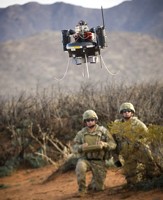On Nov. 3, 2002, America began its campaign of targeted killings in nonbattlefield settings. After a year-long manhunt, a fusion of human intelligence assets and signals intercepts pinpointed Abu Ali al-Harithi, an operational planner in the al-Qaida cell that had bombed the USS Cole in 2002, driving in a Toyota SUV in Yemen, near the border with Saudi Arabia. A CIA-controlled Predator drone climbed into position, maneuvered its nose downward and fired a single Hellfire missile, which destroyed the SUV and killed al-Harithi, along with four other Yemenis and Ahmed Hijazi, a naturalized U.S. citizen and ringleader of an alleged terrorist sleeper cell in Lackawanna, New York. In the after-action video taken by the Predator, the only identifiable item was the SUV’s oil pan.
The strike against al-Harithi was intended to be a covert operation, defined by U.S. law as one where “the role of the United States government will not be apparent or acknowledged publicly.” Then-Deputy Secretary of State Richard Armitage later conceded, “The deniability was an important component of the mission.” In the immediate aftermath, Yemeni security officials floated semi-plausible cover stories: an accidental explosion or a careless smoker who dropped a burning cigarette near a propane tank. However, in the words of then-Ambassador to Yemen Edmund Hull, “Washington could not be discreet.” As vague leaks initially emerged, Secretary of Defense Donald Rumsfeld ordered his deputy, Paul Wolfowitz, to appear on CNN, where Wolfowitz boasted of U.S. involvement in “a very successful tactical operation.”
Since America’s drone wars began 10 years ago, the Bush and Obama administrations have struggled to stage-manage public knowledge of such operations, maintaining the myth that the strikes are “covert,” while fighting off reasonable Freedom of Information Act requests and refusing to brief relevant congressional committees on the legal authority to kill U.S. citizens. At the same time, favored journalists have received off-the-record leaks by anonymous senior officials about the “precise” and “effective” nature of drone strikes. Despite both administrations’ best efforts, however, a great deal of information is available that describes U.S. policies on drone strikes -- and much of it is troubling.

